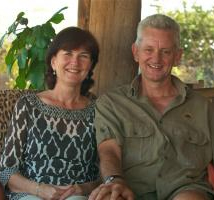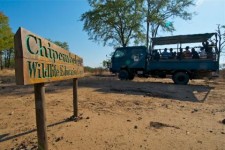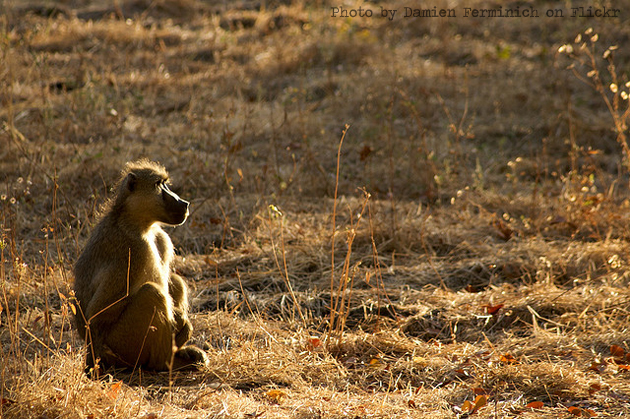Today’s children are tomorrow’s leaders, conservationists, and policy-makers. Thus, it is essential to instill critical values in youth in order to ensure the future of the environment and wildlife. Throughout Africa, many under-privileged children learn only about the environment and wildlife from what they experience firsthand, which often includes conflict with wildlife that causes much frustration and income loss. Unfortunately, these experiences can cause negative views of wildlife.
Steve and Anna Tolan realized the potential to change the future of Zambia by reaching out to youth, and in 2001 established the Chipembele Wildlife Education Trust (CWET) on the banks of the Luangwa River across from South Luangwa National Park.  The couple has dedicated their lives to educating local children about wildlife, the environment, conservation, and sustainable development. The primary focus of the Trust has been its Education Centre, which is open and free of charge to all Zambian schools to come experience and learn about wildlife and the ecosystem. CWET even offers transportation to and from the Education Centre for local schools.
The couple has dedicated their lives to educating local children about wildlife, the environment, conservation, and sustainable development. The primary focus of the Trust has been its Education Centre, which is open and free of charge to all Zambian schools to come experience and learn about wildlife and the ecosystem. CWET even offers transportation to and from the Education Centre for local schools.
When students arrive for the day, they are split into groups which compete against each other for points scored by participation and listening to educational presentations. The winning group receives prizes, providing an incentive to listen and learn. Many fun activities are used to facilitate the learning process, as CWET believes their conservation messages are most effective when the children truly enjoy and remember what they learn.
The Education Centre features a classroom, library, office, and a large interpretive room full of exhibits that display information about animals, plants, insects, poaching and anti-poaching, hunting, tourism, and environmental problems, just to name a few. In the classroom, education takes place in many forms to ensure that each child’s learning style is  addressed. These activities range from lectures or lessons, slide shows, videos, a guided bush walk, outdoor practicals, quizzes, artwork, competitions, and games. Lunch is provided and there is also a large playground complete with swings and a zip line! Students from local schools are picked up in a big open truck and have a wonderful game drive on the way to and from the Centre, allowing them to truly appreciate and experience everything they learn from CWET.
addressed. These activities range from lectures or lessons, slide shows, videos, a guided bush walk, outdoor practicals, quizzes, artwork, competitions, and games. Lunch is provided and there is also a large playground complete with swings and a zip line! Students from local schools are picked up in a big open truck and have a wonderful game drive on the way to and from the Centre, allowing them to truly appreciate and experience everything they learn from CWET.
Aside from their educational endeavors, the Trust is also involved in direct conservation of wildlife through rehabilitation and release of rescued animals. Receiving these animals from many different situations, they provide all the necessities for the critters to make a full recovery so they can be returned to their natural habitats. Warthogs are the most common animals rehabilitated, but CWET has also cared for monkeys, baboons, bushbucks, squirrels, scrub hares, a variety of birds, and many others. All animals that come for rehabilitative care are returned to the wild and are never kept as pets.
Here is a brief video about CWET’s rescued animals:
The Trust also works closely with Zambia Wildlife Authority (ZAWA) and their anti-poaching units. Over the years, CWET’s work has expanded to include the Chipembele Rangers project, school conservation clubs, school improvement projects for local communities, a Pupil Sponsorship program, community outreach and development, and even dabbles in some archaeology as the area is rich in fossils!
 While Steve and Anna conduct much of the work, CWET’s volunteers are absolutely invaluable to the Trust’s efforts. “Chipembele” is the Nyanja word for rhino, and the name was chosen for the Trust because Zambia used to home one of the highest concentrations of the now critically endangered black rhino. Rhinos in this country were wiped out from intense poaching in the ‘70’s and ‘80’s, and using that example, Chipembele hopes to instill in the children they interact with, the idea that, “if we do not look after our wildlife, even abundant species can be wiped out forever.” Their message has effectively reached many, many people in Zambia, and Chipembele Wildlife Education Trust has accomplished much to be recognized in their nine years of extensive hard work.
While Steve and Anna conduct much of the work, CWET’s volunteers are absolutely invaluable to the Trust’s efforts. “Chipembele” is the Nyanja word for rhino, and the name was chosen for the Trust because Zambia used to home one of the highest concentrations of the now critically endangered black rhino. Rhinos in this country were wiped out from intense poaching in the ‘70’s and ‘80’s, and using that example, Chipembele hopes to instill in the children they interact with, the idea that, “if we do not look after our wildlife, even abundant species can be wiped out forever.” Their message has effectively reached many, many people in Zambia, and Chipembele Wildlife Education Trust has accomplished much to be recognized in their nine years of extensive hard work.
Here is a great video about Chipembele Wildlife Education Trust:
For more information, please visit their website.
Photo #1 by Damien Ferminich on Flickr
Photos #2-4 via Chipembele Wildlife Education Trust’s website





2 Responses to “In the Spotlight: Chipembele Wildlife Education Trust”